

How can we, as urban dwellers in the twenty-first century, bring the magic and energy of plant power into our homes?
chapter 2
GOOD ENERGY WITH PLANTS
To begin with, we have to be aware of one fact: We are made of energy. This energy is both physical and spiritual and nourishes our entire life. It influences our level of well-being, which is both physical and emotional. Energy is also flowing and in constant flux—it enters our homes and it leaves our homes. We should always aim to bring in more positive energy, however, and to get rid of negative vibes. One simple way to bring positive energy into our homes is plants.
Throughout human history, plants were thought to be magical sources of energy. People worshipped plants, personified them, and attributed power to them. Plants were sacred beings in the same hierarchy as humans and animals. Back in 1973 Peter Tompkins and Christopher Bird wrote an entire book, titled The Secret Life of Plants, about the physical, emotional, and spiritual relationship between humans and plants. In it, they delve into what they call “plant mysteries” and shed light on the physics and metaphysics of plants.
Nowadays we have lost much of what was so natural and sacred to our ancestors. We often value reason over emotion; we consider our human existence superior to nature. But our world is multilayered and multifaceted. In her recent book The Enchanted Life: Unlocking the Magic of the Everyday, Sharon Blackie notes how alive we might feel if we focused our awareness on these many and varied facets—including the world of rocks, animals, plants, soil, and weather that is all around us.

Bring your full sensory attention to what you’re doing by smudging sage. Be sure to buy high-quality and ethically sourced sage.
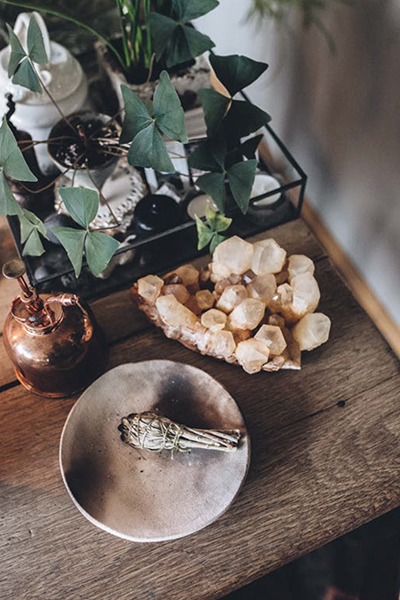
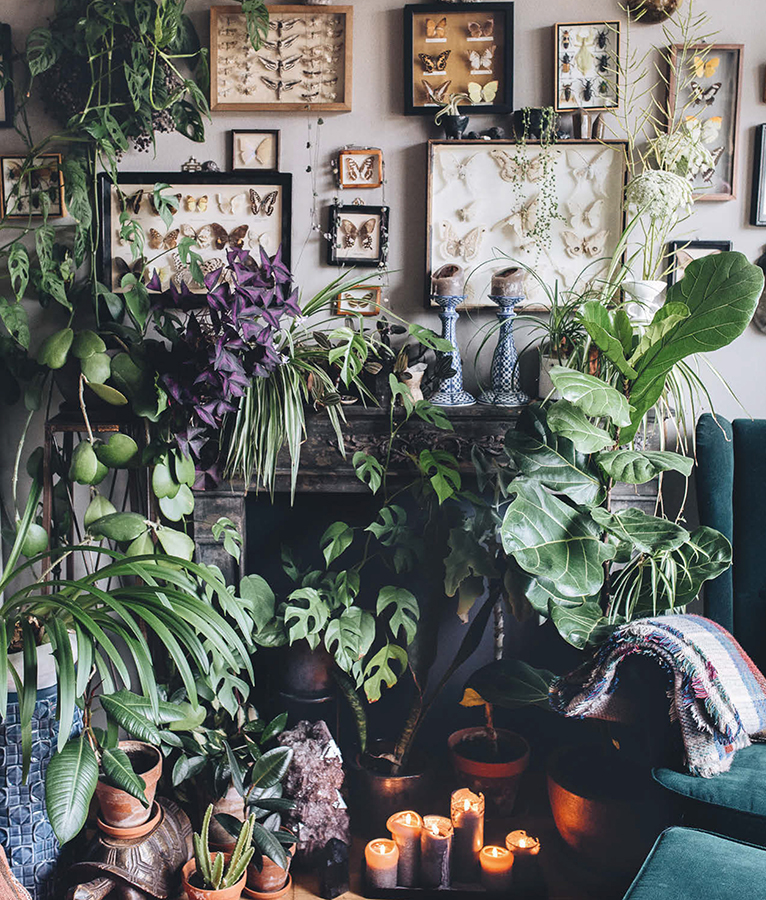
Plants, sage, candles, and crystals work together to create good vibes in a home.
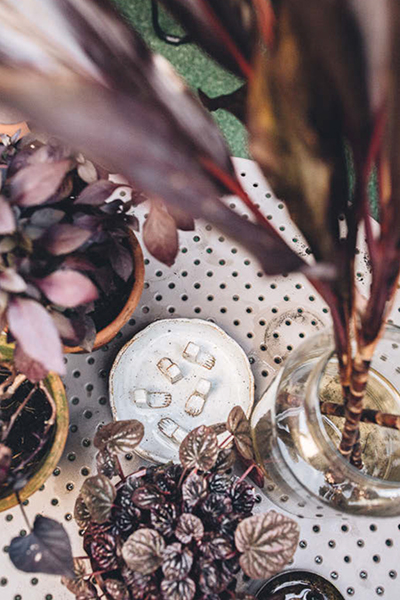
Sometimes the good energy is in the details—like exceptional plants or handmade ceramics.

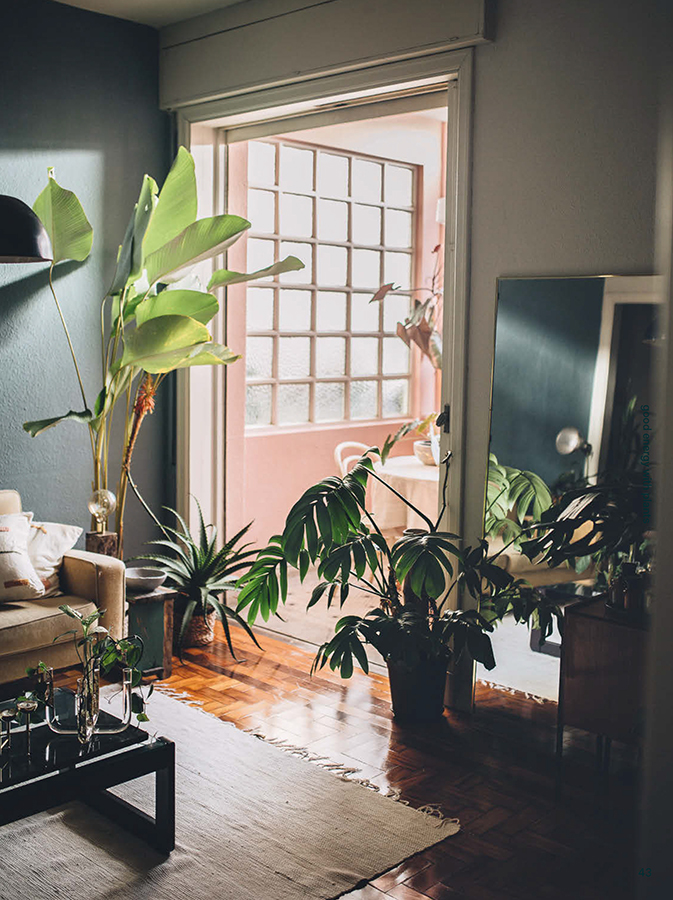
Houseplants help focus our awareness on nature, making us feel more energized and alive.
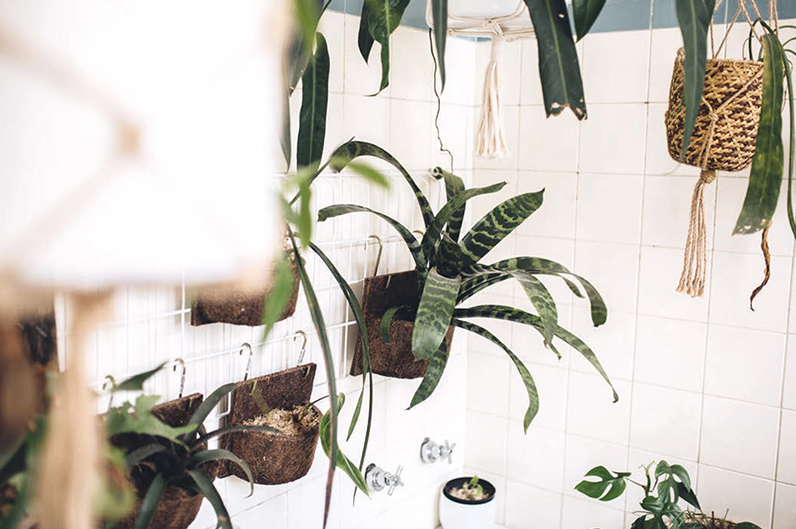
Plants help purify the air in the entire home, not only bathrooms.
2.1
purify your home with plants
It is widely known (and scientifically confirmed) that plants help purify the air in our homes. They not only absorb common household toxins from the air we breathe and release fresh oxygen but also positively impact the energy level in our homes by improving the overall living environment. Most plants have an air-purifying effect. Certain plants, however, are real power boosters for fresh air. They remove toxins that are emitted by synthetic materials and fibers in closed spaces (such as plastic, carpets, etc.), as well as by air pollution from outside. Here are six of our favorites:
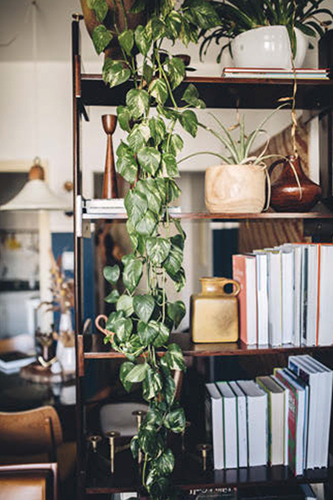
1
DEVIL’S IVY OR GOLDEN POTHOS
(EPIPREMNUM AUREUM)
Not only is this one of the easiest houseplants to grow, it is also one of the superpower plants when it comes to clean air and positive vibes. Its cascading tendrils and its leaves of varying shapes and colors are an uplifting sight and fill your space with flowing energy. Pothos grows easily in pots, hanging baskets, and even in water.
Toxins removed: benzene, formaldehyde, trichloroethylene, and xylene.

2
PHILODENDRON
Philodendron is a large genus of evergreen plants that are popular for growing indoors. Those with heart-shaped leaves, in particular, are a sheer delight: Their powerful green leaves ooze with positive energy. Most Philodendron species are fast growers and thrive in bright indirect light. They are ideal for growing as trailing plants—along shelves, door and window frames, and curtain rods—or simply climbing up your wall. The instant jungle effect elevates the mood and exerts both an invigorating and a calming power.
Toxin removed: formaldehyde.
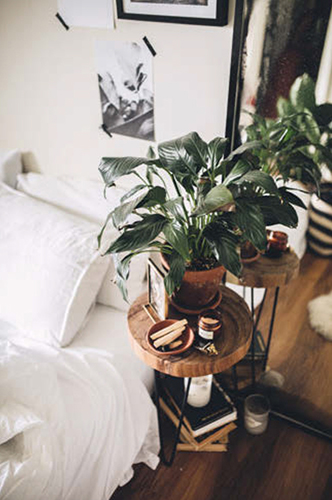
3
PEACE LILY
(SPATHIPHYLLUM)
This lush plant has all the positivity its name implies. It brings a sense of peace and harmony into your space with its oblong, deep green leaves and mostly white spathes (commonly mistaken for flowers). The actual flower grows as a spadix in the middle of the spathe. This beauty is another easy-to-care-for houseplant, and thrives in low-light conditions.
Toxins removed: benzene, carbon monoxide, formaldehyde, trichloroethylene, and xylene.
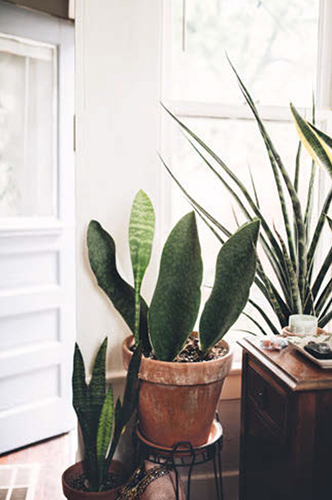
4
SNAKE PLANT
(SANSEVIERIA)
The snake plant has it all: It’s harder to kill than to keep alive and it produces good vibes in any corner—even in the shade of a hallway. In the practice of feng shui, this plant, sometimes referred to as mother-in-law’s tongue, is considered to have strong positive energies. It’s a fantastic plant for bedrooms, as its consumption of carbon dioxide and release of oxygen during the night enhance the quality of sleep.
Toxins removed: benzene, formaldehyde, trichloroethylene, and xylene.
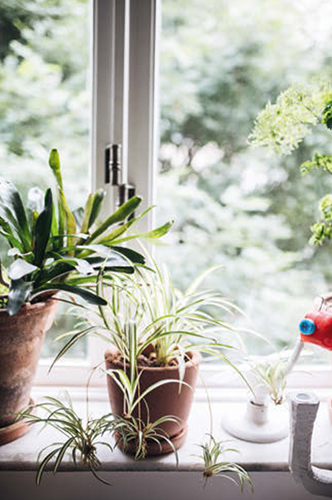
5
SPIDER PLANT
(CHLOROPHYTUM COMOSUM)
Some people consider spider plants common and unspectacular. This plant is a real source of joy, however. Owners of spider plants experience ongoing positive energy with this forgiving house-plant: It thrives with only minimal care and tends to produce many offshoots. The sight of its dangling babies will warm your heart and make you smile.
Toxins removed: formaldehyde and xylene.
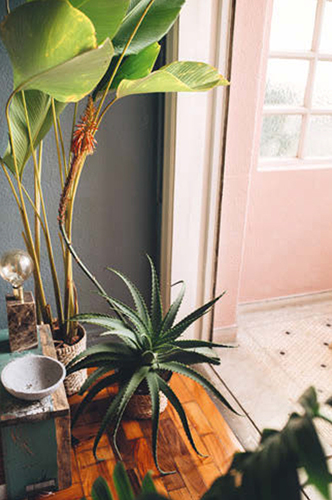
6
ALOE VERA
This is not only a plant; it’s a healer among plants. Aloe vera has been known throughout history for its healing properties and good energies. The gel from aloe vera leaves has anti-inflammatory properties for the body and soothing effects for the soul. To look at this plant and be aware of all the goodness it contains makes you appreciate nature even more. Aloes are not only strong air cleaners; they can also indicate the level of toxins in a room: Brown spots on their leaves could mean there are high amounts of harmful chemicals in the air.
Toxin removed: formaldehyde.
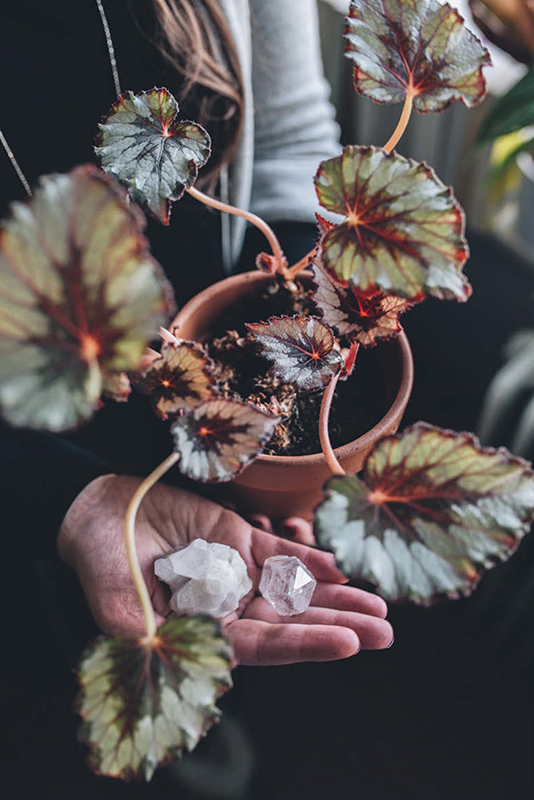
This Begonia rex rocks good vibes, thanks to some rock crystals.
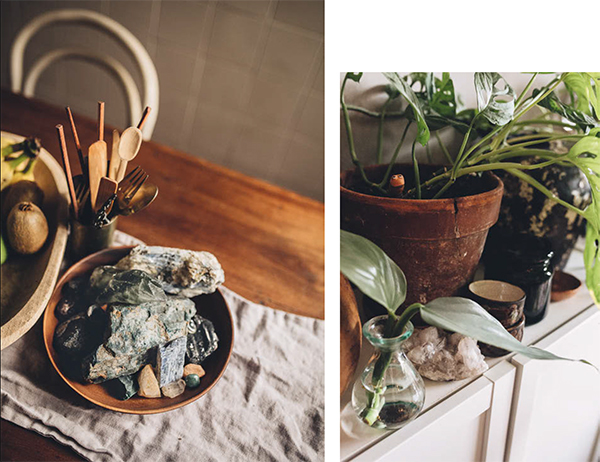
Scatter crystals around plant arrangements for extra good energy.

Negative vibes don’t stand a chance thanks to this chunky amethyst.
2.2
plants and crystals
Both plants and crystals are born from the one and only Mother Earth.
They are imbued with the powerful, ever-present energy of our planet. Gems and minerals originate deep within the earth’s crust and, in their various shapes and colors, manifest the forces that created them. Crystals and all sorts of stones have been valued for their healing and magical powers for thousands of years. And even today, we have a strong connection to their power—sometimes consciously, other times unconsciously, for example, in our choice of special stones for jewelry. Crystals and gemstones fill our lives with magic—whether we wear them on our bodies or place them thoughtfully in our homes. But what about their connection to plants?
The earth nourishes plants; the earth makes crystals—it seems like a logical conclusion that plants and crystals have a strong bond and that crystals have a beneficial effect on our plants. How can we harness the good vibrations and energies of crystals for the growth and well-being of our plants?
First, we have to identify stones that are particularly beneficial. Here are a few suggestions to get you started with some crystal magic of your own:
CLEAR QUARTZ
This is the best and most versatile crystal to start with. It’s considered one of the most spiritually healing crystals, with abundant powers. Clear quartz is connected to transformation, clarity, healing, balance, and focus. This crystal enables a constant flow of energy: It amplifies and regulates energy levels, it cleanses and fends off negative vibes—and this is as true for you, your home, and your pets as it is for your plants.
AMETHYST
This purple crystallized quartz is known for its cleansing and purifying powers. It’s also a crystal of protection and healing. Amethysts hold a soothing energy that calms and eases the mind. With its wide energy field, an amethyst placed among plants will help cleanse the surrounding area of negative vibes.
ROSE QUARTZ
This pale pink stone is popular and an excellent crystal to use in the home. It is often referred to as the “stone of love” and is considered essential for nurturing and healing. It soothes the body and mind and helps open the heart to new experiences. Rose quartz is also believed to promote fertility and thus can help your plants thrive and grow. Support young plants, cuttings, and offshoots especially with a rose quartz.
SMOKY QUARTZ
Smoky quartz crystals come in various shades, from translucent to opaque brown, and have a strong connection to the earth. They are famous for their grounding powers and for energy transmutation. They divert negativity and leave a clean space for growth and stabilization. Smoky quartz is a great crystal to help strengthen ailing plants.

Gems and minerals originate deep within the earth’s crust and, in their various shapes and colors, manifest the forces that created them.
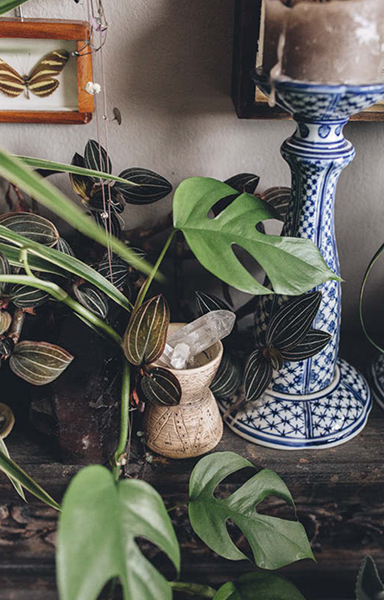
Clear quartz is one of the most powerful crystals: Place little quartz pieces next to plants to boost their energy levels.
CITRINE
This member of the quartz family comes in soft to bright yellow or orange hues. It is connected to mental clarity, optimism, and regeneration. The citrine also promotes abundance, and is considered helpful when you want to let your creative juices flow. For lush growth, place a citrine close to your plants, but don’t combine it with clear quartz, as the two together are too powerful.
MOSS AGATE
This green crystal is the most powerful of all agates and is often referred to as the crystal of farmers and gardeners. It’s said to bring abundance and prosperity, and to strengthen the connection to the earth. Use a moss agate or a group of them around your plants—they will benefit from the crystal’s powerful energy and will respond with health and vitality.
AMAZONITE
Amazonite is feldspar, which means it’s a crystalline mineral. It’s said to help us find harmony with others and with our environment, and it encourages speaking the truth and finding our flow and inspiration. Amazonite is also known for its balancing powers. It interacts well with plants and will help yours stay balanced and grounded.
PETALITE
This feldspar has a reputation as a high-vibration stone. It emits a high level of positive vibes and keeps negativity at bay. This stone helps us connect with the spiritual realm and balances the energy level in its vicinity. It’s also considered a protective stone and has been used as a talisman throughout history. Petalite is said to relieve stress levels, so place one among your plants to keep the good vibes balanced and the negative, stressful energy away.
TOURMALINE
Protection, security, and stress relief are associated with tourmaline. This crystal comes in various dark shades, and black tourmaline is one of the most popular stones when it comes to positive effects. It’s literally a bodyguard stone, cleansing negative energy wherever you place it—whether on your body as a piece of jewelry, in your car, next to your computer, or among your houseplants. If you want a strong purifier and cleanser to keep positive vibes in your home, go for a black tourmaline!
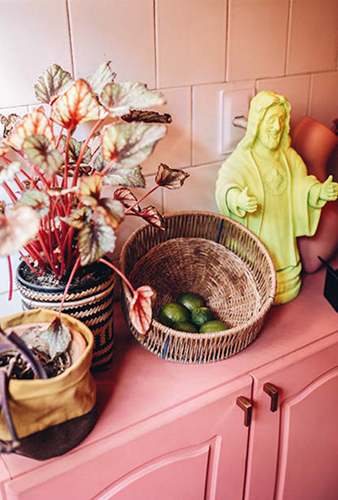
Symbols of all kinds can raise energy, too. Here, a neon statue stands guard over a Begonia rex.
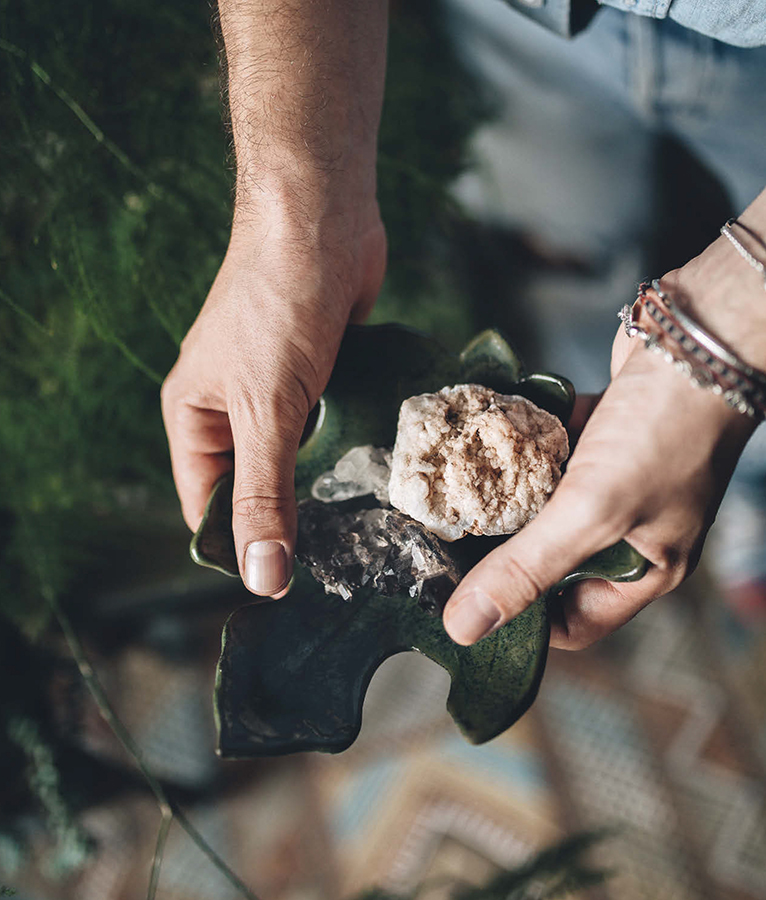
A rock from the Moroccan Sahara Desert, a smoky quartz, and rock quartz placed in a handmade fig leaf bowl.
APATITE
Although it is most commonly deep blue or green, apatite comes in a multitude of colors. It’s a calcium phosphate mineral and a main source of phosphorus for plants, which makes it a great stone to put in your flowerpot: The plant will be energized directly through the soil. You can also use this stone to infuse water to drink yourself or for watering your plants!
Now that you have this list of crystals that are good for your plants in hand, it’s time to consider how to use these crystals in order to transfer their good energy to your houseplants. Try one, a few, or all of these ideas:
Place crystals next to your plants
Sometimes the simplest idea is a good idea! Placing crystals next to your plants is an efficient and decorative way of imbuing your plants with the positive vibes exuded by crystals. Arrange a cluster of clear quartz next to your plants, and add smoky quartz, amethyst, or moss agate—play with the combinations. Just avoid combinations that are too strong, like clear quartz with citrine. This way your plants will get all the positive energy and your plant arrangement will sparkle and shine.
Put crystals in your flowerpot
This is the most powerful way to channel crystals’ positive forces to your plants. By placing crystals in your flowerpot, you will fuel the plant with good energy. Be sure to use only suitable crystals, however, as the chemical constituents of certain crystals (lead or arsenic, for example) can be harmful to plants when dissolved in water. All crystals from the quartz family—clear quartz, amethyst, rose quartz, smoky quartz, and citrine—are chemically “clean,” however, and can go directly into your flowerpot. These are compounds of silicon and oxygen (SiO2), with minimal traces of iron, aluminum, or titanium. Various unpolished stones are also ideal for placing on top of soil: a pink petalite, an amazonite, apatites, or tourmalines, for example.
Wear or carry crystals while tending to your plants
Don’t forget that crystals have a powerful energy field that you can carry with you—for example, while caring for your plants. Why not put a powerful and energy-packed crystal in your pocket or around your neck or wrist (as a piece of jewelry) while you minister to your plants? The positive vibes will radiate and make both you and your plants look beautiful and well energized!
Water your plants with crystal-infused water
If you’re already a firm believer in the positive effects of stones and crystals, this will come as no surprise: It’s often recommended that we drink crystal-infused water, to absorb the properties of crystals and infuse our body with the positive effects. Now, what is good for our bodies is usually good for our plants, too. So why not prepare crystal-infused water for your plants? Clean your stones and place them in a watering can or a carafe. Add water (purified or distilled water, or rainwater) and infuse for a minimum of three hours or overnight. Start with the basic combination of amethyst (harmonizing), rose quartz (cleansing), and clear quartz (invigorating). Other great stones for watering your plants are aquamarine (boosts growth), moonstones (enhances vitality), and polished hematites (energizing and grounding). You can also use crystal-infused water in your mister every now and then! Spritz that good energy around!
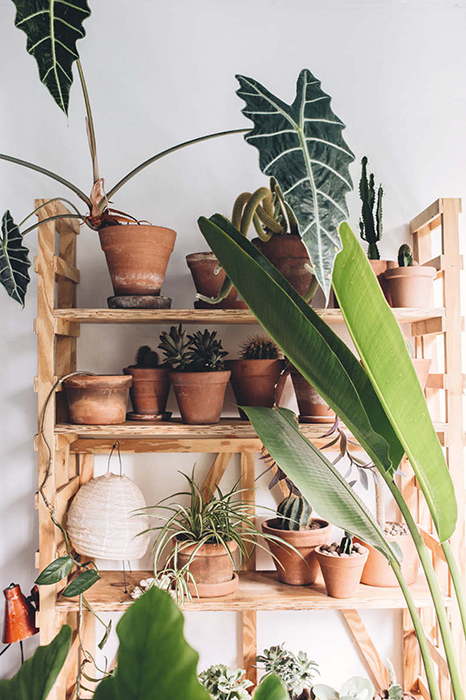
A thriving Alocasia reigns over this plant shelfie with a variety of potted plants in terra-cotta pots.
2.3
let the energy flow with plants
In this chapter we’ve seen how plants can physically enhance the energy in our homes by purifying the air we breathe. We’ve also seen the positive effect of combining plants and crystals to bring in the good vibes. Now let’s have a look at plants that are said to be bearers of good energy themselves, and let’s also think about the ideal placement of plants to let the energy in your home flow.
When we speak of positive energy in the home, we have in mind the principles of feng shui. Feng shui is an ancient Chinese system of rules that govern spatial arrangement and orientation in relation to the flow of energy. Plants can contribute to the level of positive energy in many ways. They can balance the water element (one of feng shui’s five elements; see this page), bring fortune or luck, counteract negative forces, and bring a piece of nature indoors. Using the right plants can help balance energy levels in your home and contribute to a more wholesome living environment.
If you want to boost the positive energy in the space where you live, add one or a few of the following plants:
JADE PLANT (CRASSULA OVATA)
This hardy succulent, it’s claimed, supports the luck of its owners. The fleshy, round leaves symbolize good fortune, and the plant is best placed in areas of the home connected to money and success. So how about adding a jade plant to your home office?
LUCKY BAMBOO (DRACAENA SANDERIANA)
In feng shui practice, this plant is considered the most favorable when it comes to good energy.
Lucky bamboo activates stagnant energy and enhances the flow of positive energy throughout the home. The lucky bamboo can go literally anywhere in your space!
ORCHIDS
In feng shui, orchids are connected to serenity and love. They help improve relationships, promote peace, and enhance a serene atmosphere. Orchids are best placed in the relationship corners of your home (those areas where we tend to be closer to our significant other)—one ideal place is the bedroom (see this page) but it can also be near the sofa or the tub, basically anywhere you live out your relationship. And orchids come in a huge variety. So if you’re not a big fan of the common Phalaenopsis orchids (which can be found in most supermarkets), opt for a more exotic beauty like a Cymbidium orchid.
BOSTON FERN (NEPHROLEPIS EXALTATA)
The Boston fern is considered a welcoming plant. It is best placed in your entrance area or home office. This lush plant is also one of the best natural air purifiers, making it a true good-energy plant for every home!
MONEY TREE (PACHIRA AQUATICA)
Like the jade plant, the money tree is believed to enhance abundance and prosperity. Add one to your living room or home office for an uplifting effect on your work and creativity.
HERBS SUCH AS BASIL, ROSEMARY, AND THYME
These fragrant plants will bring positivity into your home in an instant. The aroma infuses rooms and heightens our sense of smell. They are believed to bring good energy into the home and are a perfect addition to kitchens.
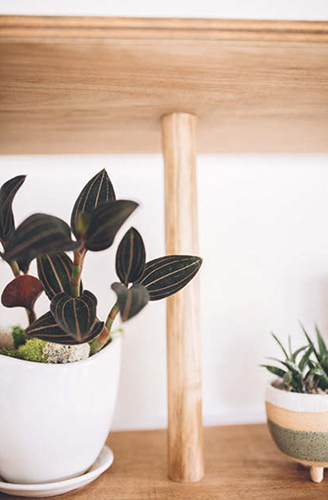
The jewel orchid, also known as Ludisia discolor, is an easygoing beauty, with its stunning foliage and delicate white blooms.
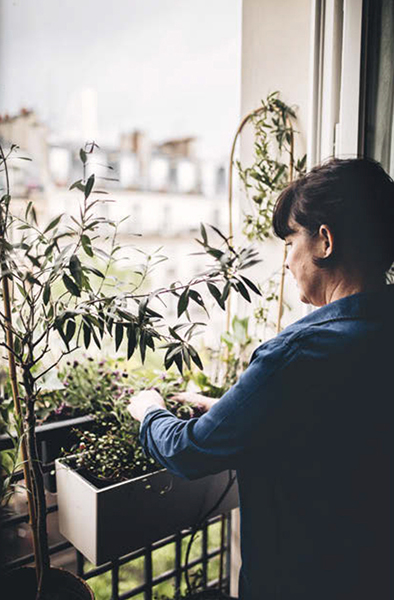
Grow fragrant herbs, like rosemary, thyme, or lavender, in the windowsill and serve yourself before any meal.
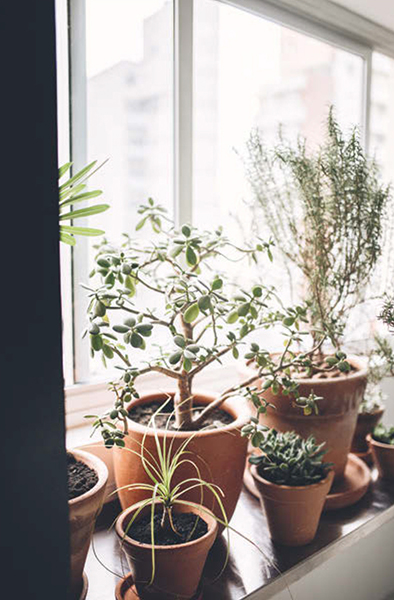
Like lucky bamboo, most Dracaena are very easygoing. Prune their canes (the stems of a Dracaena) and new foliage will sprout just below the cut in a few weeks. Propagate the removed cane for another plant.
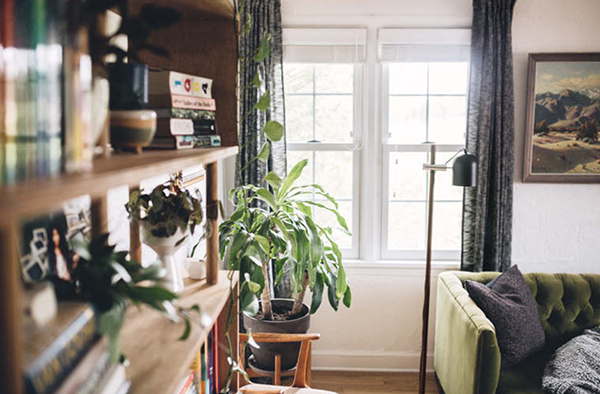
Crassula ovata, commonly known as jade plant, lucky plant, or money plant, is a succulent plant, native to South Africa and Mozambique.
According to feng shui, any plant that is vibrant, lush, and healthy will bring good energy—so the most important principle is to keep your plants happy and healthy. Whatever plant is dear to your heart and gives you a good feeling is the right plant for your home. Principles and rules are one thing, but nothing beats your intuition and feelings. So go for what makes you feel good, happy, and invigorated!
When it comes to the ideal placement of plants, the first and foremost rule is to listen to your intuition. Decorate your home with plants in the way that you like and that suits your personal style. In general, the addition of plants positively impacts our mental and physical health; they are beneficial for our creativity and help us unwind and focus.
Another rule concerns the growing conditions in your home. The levels of light, temperature, and humidity should always be considered when deciding on plant placement.
The principles of feng shui add another dimension when it comes to determining the placement of plants. Plants are used to attract love, to increase learning abilities and prosperity, and to improve overall luck. The principles work based on the bagua areas of your home, defined by the five elements (wood, fire, earth, metal, and water). Plants are part of the wood element and thus ideal for the east, southeast, and south bagua areas of your home. The north area should have only a few plants. But here again, we believe in the power of your plant-loving intuition; wherever you feel plants are thriving and happy, and making you happy, that’s where you should place them!
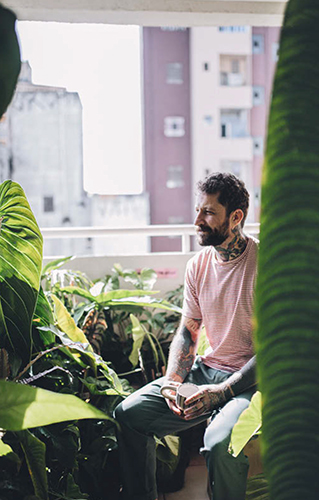
plant tribe stories . . .
Michell Lott
“I learned to care for myself thanks to my plants.”
Location
São Paulo, Brazil
Profession
Journalist, set designer
Zodiac
Sagittarius
Lives with
Partner Felipe and friends Júlia and Renata
Apartment size
968 square feet / 90 square meters
Favorite plant
Euphorbia cotinifolia
Plant decor idea
If you have too little light for plants to thrive, use dried plants to create a forest or savanna-style jungle, and don’t be afraid to celebrate the different life stages of plants. For brightly lit areas, opt for dramatic colors and experimental arrangements. The more dramatic your interior design, the more outstanding your plants should be!
Number of plants
55
@lottlott @efirocha @julia.anadam @renatamiwa
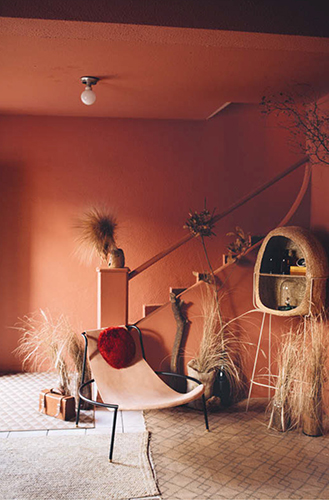
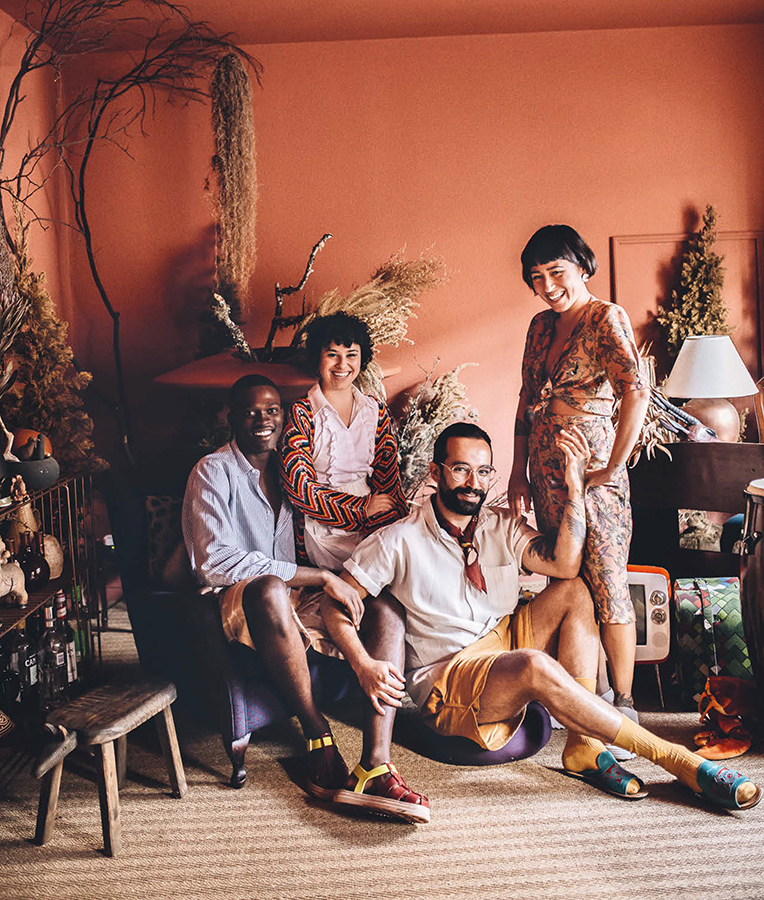
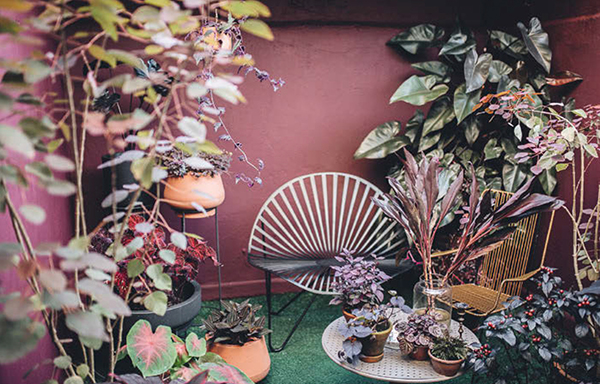
The patio garden features an array of extraordinary plants in any color but green.
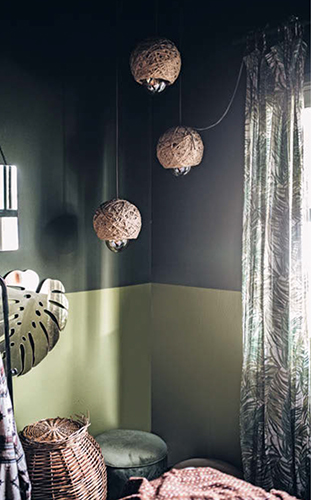
The green and botanical vibe in Michell and Felipe’s bedroom, even without plants.

Welcome to the cosmic spiritual retreat house of Michell Lott.
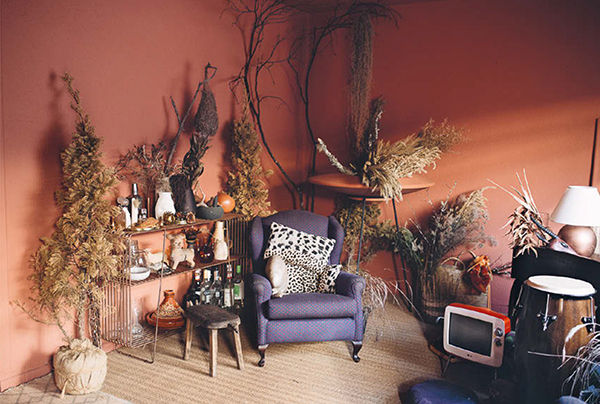
Michell believes we should celebrate all the stages of the plant cycle—noting that even dried plants can be a wonderful addition to a room.
There are homes with beautiful interiors, there also are homes with artistic interiors, and then there are homes that are art themselves. One of those is the São Paulo home of journalist and set designer Michell Lott. Hidden in a courtyard in the trendy Pinheiros district is the Casinha do Retiro Espiritual Cósmico, which translates to something like the cosmic spiritual retreat house. And the cosmic energy is palpable.
Michell Lott is truly a creative soul. You can see it from the moment he opens the door: His aura sparkles, he is both charming and inviting, as well as mysterious and intriguing—and his warm and cheerful Brazilian soul shines through it all. And not only his—he shares this amazing home with his partner, the musician and model Felipe Rocha, as well as creatives Júlia Anadam and Renata Miwa.
Michell’s work as a set designer has a strong impact on the way he lives. “Having plants is something that connects to my work as a set designer; some of my plants were part of my set designs and I brought them back home. For me, plants are also a way to connect to myself and to nature again—especially in a big city like São Paulo.” This philosophy is reflected in every corner of the house. The entrance lounge, which is too dark for houseplants, is painted a beautiful terra-cotta hue and hosts a fantastic savanna of dried plants and flowers.
Just off the kitchen, which is a visual explosion of radiant red and fluorescent yellow hues, lies perhaps the most colorful urban jungle in São Paulo—the courtyard garden. Enclosed by deep purple walls and boasting a collection of Michell’s favorite plants, it includes Euphorbia cotinifolia as a highlight plant, several varieties of dark philodendron, plus begonias, Coleus, and bunches of dried flowers, too.
The upper floors continue the lush sweep of color, with bedrooms painted in dusky pink, mustard yellow, and deep green.
Plants can be found in every room, but the outdoor courtyard reigns supreme as the main gathering spot and favorite place to relax, reflect, celebrate, and discuss new ideas and projects. Moreover, it is a strong connection to nature. “Being with plants helps [us] to connect to ourselves again. Also they make every place prettier,” concludes Michell with a whimsical smile.
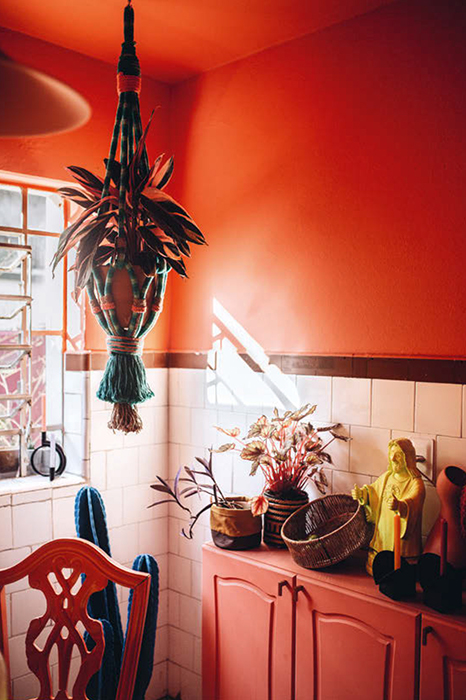
A colorful Stromanthe triostar matches the vibrant palette of Michell’s kitchen.
plant tribe stories . . .
Ben Mayer
“I am a gardener at heart. Plants have always been my friends.”
Location
Munich, Germany
Profession
Hair and makeup artist
Zodiac
Virgo
Lives with
Solo
Apartment size
647 square feet / 60 square meters
Favorite plant
Philodendron gloriosum
Plant decor idea
Make your own handmade ceramic hanging pots and fill them with trailing plants to create a vertical jungle.
Number of plants
138
@_neon_beige_
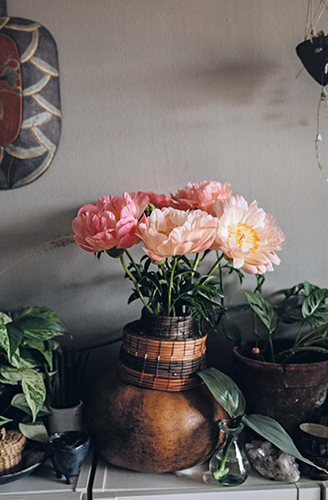
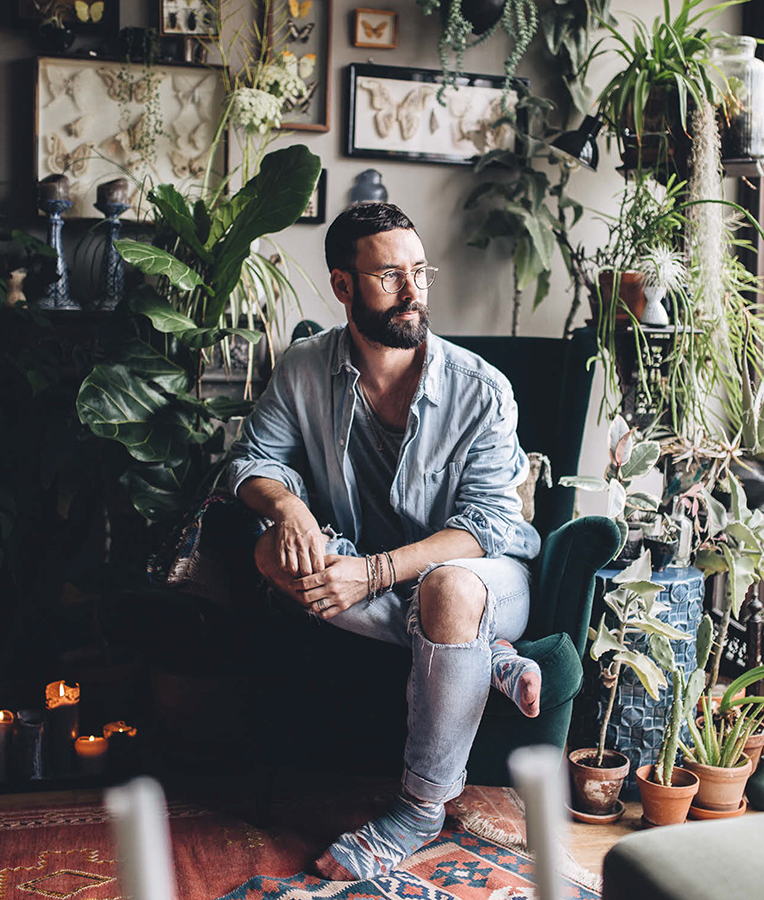
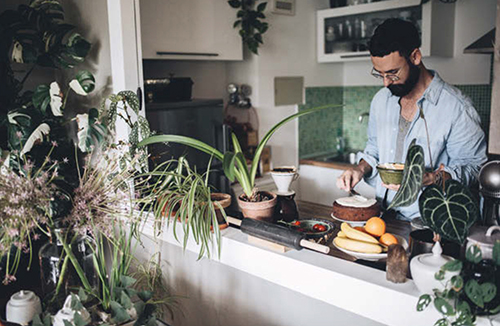
The open kitchen is framed by various plants such as spider plants, Monstera acuminata, and Anthurium clarinervium.
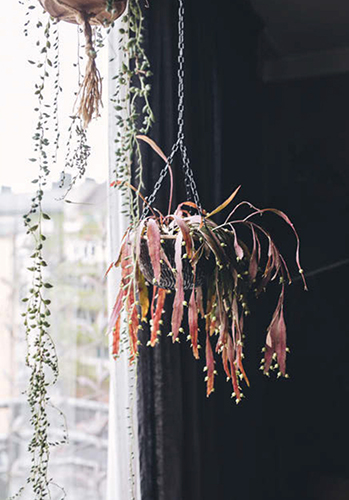
A Pseudorhipsalis ramulosa adds color to the moody apartment.
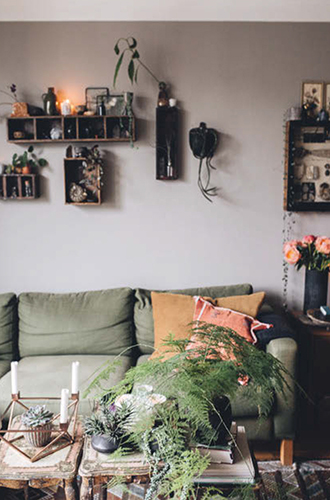
The asparagus fern enjoys the bright indirect light in Ben’s living room.
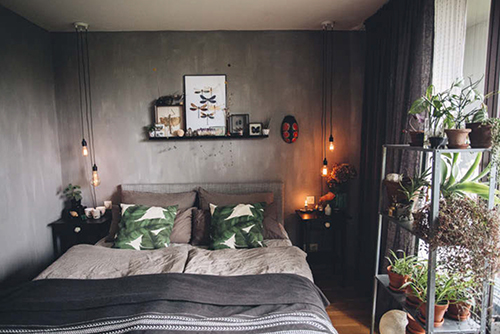
Ben’s bedroom features a plant shelf that functions as a plant nursery, too.
Munich is a picturesque and serene city in the south of Germany. It features abundant green-ways, parks, and an alpine river flowing through the city center. It is also home to a space that any plant fan would love: the eclectic, moody, and very personal apartment of freelance hair and makeup artist Ben Mayer.
The Bavarian native grew up surrounded by gardens and forests, so he is deeply connected to plants and nature. As a kid, he collected stones, shells, and botanicals, and his passion and interest in all three has never ceased. Today, he runs a garden allotment not far from his city apartment and dedicates his free time to making pottery.
Ben’s apartment is a thriving urban jungle and a genuine treasure trove. Handmade ceramics—planters, mugs, plates—are scattered everywhere, crystals large and small are dotted between the plants, shells and fossils are beautifully displayed, and a big feature wall holds a collection of framed butterflies (see this page). Kilim rugs from a trip to Morocco add color to the moody, gray walls and vintage furniture.
“I have always been interested in gardening and plants. As a kid, I wanted to become a gardener or florist. I have always had plants, but I admit right now I have more than ever before. I am a collector—always on the hunt for new plants and objects,” says Ben. “I started pottery to create ceramic pieces that suit my needs and my style—especially for plant pots.” Natural objects like crystals and shells also play a key role in his style. “I like to believe they bring positive vibes into my home and life,” he concludes.
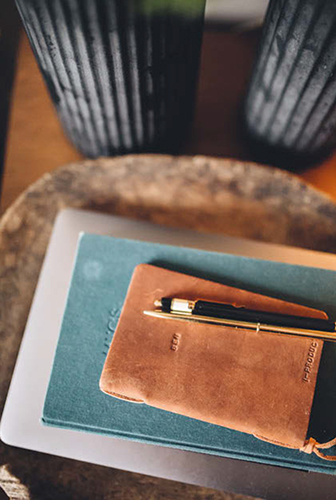
Making notes of the evolution of your plants can help deepen your knowledge of your green friends.
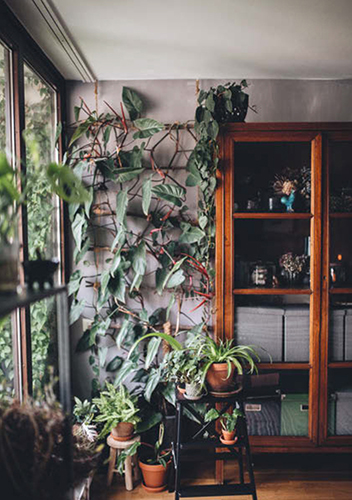
Thriving plants wherever you look bring everything to life.
plant tribe stories . . .
Derek Fernandes
“You can definitely live with plants and pets together!”
Location
São Paulo, Brazil
Profession
Architect
Zodiac
Aquarius
Lives with
Cat Baunilha
Apartment size
861 square feet / 80 square meters
Favorite plant
Philodendron erubescens
Plant decor idea
Create a floating shelf above a table.
Number of plants
Approximately 50
@derekfernandes @vanillaeamigos


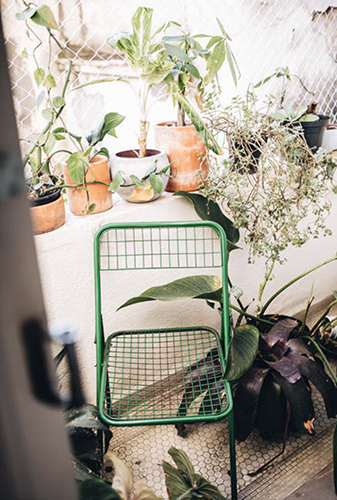
The tiny bedroom balcony functions as a plant hospital for infested plants.

A handmade floating shelf with integrated designer lighting creates a wonderful plant shelf without taking any precious floor space.
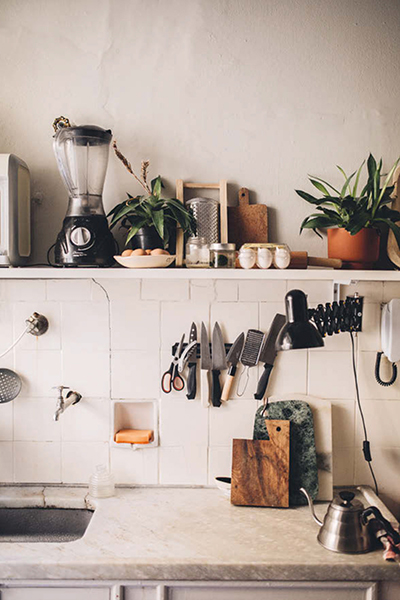
Retro vibes in Derek’s kitchen.

The Philodendron ‘Red Emerald’ thrives in the soft glow of Derek’s pink dining room.
Diffused light flows throughout the stylish São Paulo home of architect Derek Fernandes. The shadows of a tall Strelitzia play on the anthracite wall in the living room, creating a dramatic countereffect to the light-flooded, soft pink dining nook. Baunilha (Portuguese for vanilla) struts through the room, her fluffy, light fur making her the perfect hue for this apartment. Every detail reveals Derek’s impeccable aesthetic. As an architect he understands proportion, but as a vintage furniture lover he also knows that accessories, colors, and textures bring magic to a space.
Derek’s attachment to plants has somewhat unusual beginnings: After a breakup led him to a new home, he discovered how well houseplants can soothe the spirit. In his new place, Derek began dedicating more time and care to his plants, nurturing them into a little jungle. Caring for plants helped Derek rediscover happiness in his daily life and lifted him out of an emotional low.
Today his home is filled with more than fifty plants, some on a tiny balcony outside the bedroom, many on display in amazing plant installations he builds himself, like the floating jungle above the dining table.
Interestingly, nearly all the plants in his home were given to him, which simply reminds us: Sometimes a plant is the most beautiful and meaningful gift you can offer a friend!